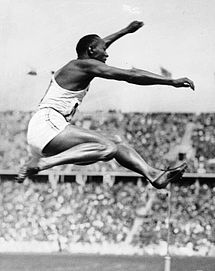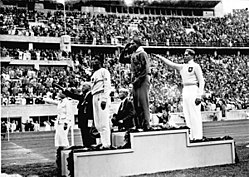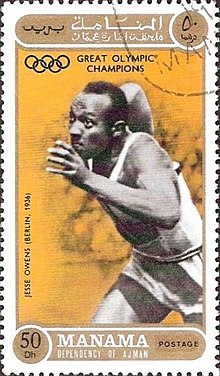Jesse owens
James Cleveland «Jesse» Owens (Oakville, Alabama, September 12, 1913-Tucson, Arizona, March 31, 1980) was an American athlete. At the 1936 Berlin Olympics he gained international fame by winning four gold medals in the 100 m, 200 m, long jump and the 4 × 100 m relay race.
In his heyday he was considered "the best and most recognized athlete in history". One of his most notable feats was the achievement of three world records, and equaling another all-time mark during the competition Big Ten Conference of the year 1935.
The Jesse Owens Award is USA Track and Field's most significant recognition for the best track and field athlete of the year.
Biography
Childhood and youth
Jesse Owens was born in Oakville, Alabama, on September 12, 1913, the youngest of ten children (three girls and seven boys) born to Henry Cleveland Owens and Mary Emma Fitzgerald. "J.C.," as he was known, was nine years old when the family moved to Cleveland, Ohio, in search of a better future during the Great Black Migration, when 1.5 million African-Americans fled the prevailing segregation in the south of the country. When he began his school years in this city, his teacher asked him for his name, to which the young man replied " J. C. »(pronounced in English jay-cee ), but, due to his thick southern accent, the educator understood Jesse . This was the reason that he was known as Jesse Owens from then on.
In his adolescence he worked in different trades during his spare time: as a merchandise delivery man, a stevedore in freight cars and in a shoe repair shop, while his father and brother worked in a steel mill. In those years he began his interest in speed racing. Charles Riley was his coach at Fairmont High School, and he was so instrumental in Owens' instruction that he was held responsible for his success in athletics. Riley also earned him esteem, as he gave her the opportunity to train before school hours, since he worked in the shoe shop after school.
In that same institution he met Minnie Ruth Solomon, his future wife, when he was 15 and she was 13. In 1932, their first daughter, Gloria, was born. Owens and Solomon were married in 1935 and had two more daughters: Marlene, born in 1939, and Beverly, born a year later.
As early as 1933, while a student at East Technical High School in Cleveland, Owens drew national sporting attention by equaling the world record of 9.4 s in the 100-yard dash.) and achieving a mark in the long jump of 7.56 m during the national high school championships that took place in Chicago.
Sports career
At The Ohio State University
Owens attended Ohio State University after his father got a job. In this educational institution he was known as "The Bullet", and as part of the University he achieved eight titles during NCAA competitions: four in 1935 and as many in 1936. However, despite his sporting success, he had to stay outside the college campus alongside other African-American athletes. Likewise, when he traveled with the team, he had to comply with certain provisions, among others, placing his orders in restaurants only in the take-out service and attending exclusive dining rooms for African-Americans; the same was the case with hotels. In fact, he never received a scholarship for his sporting achievements, so he continued to work part-time to pay for his studies.
Particularly special was the year 1935, when on May 25 he performed a memorable 45-minute feat in Big Ten Conference competitions held at Ferry Field in Ann Arbor, Michigan. On that day, he set three world records and equaled another one: In the 100-yard dash he ran in 9.4 s, tying the world record, and the new records to his account were in the long jump (8.13 m, which would remain for 25 years), 20.3 s in the 220-yard dash (201.2 m), and 22.6 s in the low hurdles 200-yard dash, which was the first known mark under 23 s. In 2005, University of Central Florida sports history professor Richard C. Cepreau noted that he considered those marks achieved in a single day to be the most impressive undertaking in track and field since 1850.
The Olympic Games in Berlin
"I left my feet as little as possible on the surface. I always accelerated when I touched the ground and when I stood up." —Words of Owens about his technique in racing. |
In 1936 the Olympic Games were held in the city of Berlin. With Adolf Hitler in power, the event was intended to show the world the progress of Nazi Germany. The Führer, like other members of the government, expected German athletes to dominate the disciplines. sports.
In this context, Owens arrived in Berlin to compete for the United States. According to the statements of his teammate James LuValle, winner of a bronze medal in the 400 m, Owens was expected by many fans, mostly young German women who shouted Wo ist Jesse? Wo ist Jesse? (Where is Jesse?). Many of them had arrived with scissors in their hands to try to cut fragments of his suit, forcing the athlete to get back on the train. After that episode, when he left the athletes' village, he must have done it with a group of soldiers to protect him.
His international fame was also recognized by Adi Dassler who visited him in the Olympic village. Dassler, the future founder of the Adidas company, convinced him to use the shoes of the Gebrüder Dassler Schuhfabrik company, which became the first sponsorship for an African-American athlete.
On August 3rd Jesse Owens won his first gold medal. He conquered it in the 100 m race with a time of 10.3 s, ahead of fellow student Ralph Metcalfe by one-tenth of a second, and Tinus Osendarp of the Netherlands by two-tenths of a second. The following day, on August 4, he achieved his second victory of the games in the long jump with a mark of 8.06 m, although he would later reveal that a technical recommendation suggested by the German Luz Long, one of competitors. In this discipline, the American already held the world record with a record of 8.13 m, which he had achieved the previous year.
On August 5, he won the 200 m race with a time of 20.7 s ahead of Mack Robinson; and on August 9, he took his fourth gold medal in the 4 × 100 m relay. In this competition, trainer Dean Cromwell had replaced Marty Glickman and Sam Stoller with Owens and Ralph Metcalfe, who completed the team with Frank Wykoff and Foy Draper to set a world record of 39.8 s. The four-medal feat of Gold would not be matched until the 1984 Los Angeles Olympics in which Carl Lewis won the same amount in the same events.
Jesse Owens, Adolf Hitler and the Republican Party
Several versions have circulated around Jesse Owens and Adolf Hitler about their possible meeting during the games. From the first day of the competition, it is known that Adolf Hitler only greeted the German athletes who had won medals and then left the stadium. For this reason, the officials of the Olympic committee insisted that he greet all the medalists without distinction, or none at all. Hitler decided on the latter option and therefore missed the medal presentation. However, some historians have noted that Hitler may have avoided attending the games because of the threat of rain, which would have caused the delay of the games. the events. This decision could have been made before Owens' participation, but this did not prevent the president from always being believed to show disdain for the African-American athlete. About these assertions that Hitler deliberately avoided recognizing his triumphs and therefore rejecting him any salute, Owens asserted:
Hitler had controlled his time both to get to the stadium and to leave. It happened that he had to leave before the 100 m medal ceremony. But before he left, I started to appear on a television broadcast and I passed by where he was. He greeted me and I corresponded to him. I think it's bad to criticize him if you're not aware of what really happened.
However, the words of Albert Speer have supported the version of Hitler's alleged disdain for Owens. According to Speer, Hitler was "very upset by the triumphs of the American negro". [Because] anyone who had ancestors from the jungle was a savage; his physical constitution was much stronger than that of the whites and therefore they should have been excluded from the games ».
In a 2009 interview, Siegfried Mischner, a German journalist, claimed that Owens had a photograph of Hitler holding out his hand in his wallet. Owens, who believed that the newspapers had treated the Führer unfairly in their reporting, in the 1960s tried to convince Mischner and his colleagues to change the more widely accepted, but mistaken, version of Hitler's treatment of His person. Mischner claimed that Owens showed him that photograph and that Owens told him that "it had been one of his greatest moments" of him. Mischner added: "[The photo] had been taken behind the presidential box and therefore had not been covered by the press. I watched her, he was shaking Hitler's hand!" According to Mischner, “in post-war Germany the idea prevailed that Hitler had ignored Owens, so we decided not to reveal the existence of the photo. We agreed that Hitler should be considered evil in relation to Owens". However, Mischner's assertion has not been confirmed, and he himself stated in a statement to Mail Online: "all my colleagues are dead, Owens too. I know it's the last chance to tell the truth. [But] I have no idea where the photo is or if it still exists."
However, in 2014, Eric Brown, a distinguished British air pilot, claimed in a BBC documentary that he had seen "Hitler shake Owens's hand and congratulate him on what he had achieved". The Baltimore Sun of August 1936 reported that Hitler had sent Owens a photo dedicated to him.
Back in his country, Owens' life had a series of ups and downs. While in Germany the athlete could travel freely and stay in any hotel, in the United States he had to stay in segregated hotels like other African-Americans. However, when the confetti parade was taking place in New York in his honor down Fifth Avenue, he received a very particular recognition: someone handed him a paper bag, to which he paid no attention until the parade was over.. Opening it, he found inside $10,000 in cash. His wife would later declare that "he didn't know who would be so good to do something like that. With all the fuss around, he didn't pick her up immediately, he did when he got out of the car ».
In contrast, after the parade, the honoree had to use the Waldorf-Astoria elevator to attend another celebration in his honor. Another displeasure for the athlete was the behavior of President Franklin D. Roosevelt who never extended an invitation to him. the White House after his triumphs in Berlin.
Owens, who joined the Republican Party upon returning from Europe, received money to garner votes among African-Americans for presidential candidate Alf Landon for the 1936 presidential election. It was at this stage that he took the opportunity to make some Demonstrations regarding his meeting with Hitler. In Baltimore, on October 9, 1936, he assured: «Some say that Hitler despised me. But I tell you that he did not. I'm not saying anything against our president. Remember, I'm not a politician, but also remember that the president didn't send me any congratulatory messages because, they say, he was too busy." Later, on October 15, Owens repeated the same thing when speaking to an audience of African-Americans at a political rally in Kansas City. There he stressed that Hitler had not ignored him and that "it was our president who did it. The president did not even send me a telegram."
After Berlin
At the end of the games, Owens and his Olympic teammates received an invitation to travel to Sweden. He claimed that by returning to the United States he would capitalize on his fame and thus get the best sponsorship deals. On the contrary, the national athletics authorities opposed him and withdrew his amateur status, which ended his sports career. Owens, annoyed, exposed: «The world of athletics is becoming a farce. It no longer means anything to us athletes. The AAU takes all the profits. He takes all our money in this country and chases you in Europe to get his share. Your own compatriots take away what belongs to you."
Despite the decision taken by the athletic authorities, sports sponsorship offers did not disappear. In 1946 he participated in the founding of the West Coast Baseball Association (WCBA) together with Abe Saperstein, in what was an Afro-American Baseball League; and in which Owens was vice president and owner of the Portland Rosebuds team. With the Rosebuds he toured the country, and on certain occasions entertained spectators in the middle of a double game by challenging the speed of a horse. However, the WCBA barely lasted two months.
The former Olympic champion tried to work as a sports promoter, specifically as an event organizer. He also participated in 100-yard (91.4 m) sprints in which he gave the advantage to his competitors by leading 10 or 20 yards, despite which he was the winner at the end of the race. He also continued to participate in shows where he challenged racehorses.As he later revealed, he faced a horse that was easily startled by the noise of the starting gun, which prevented him from doing a good trot. Regarding these races, Owens was of the opinion that “people said it was demeaning to see an Olympic champion compete with a horse, but what could he do? He had four gold medals, but he couldn't eat them ».
Also, Owens owned a laundromat and worked at a gas station for extra money; but he could not avoid falling into bankruptcy. He was tried for tax evasion in 1966. Having hit rock bottom, he found help from the government, which appointed him a goodwill ambassador. Upon retirement he became a racehorse owner.
Regarding the incident at the 1968 Mexico Olympics where sprinters Tommie Smith and John Carlos performed the Black Power salute, Owens did not show his support. In this regard he said:
It's a meaningless symbol. When you open your fists, you have your fingers, which are fragile. The only time the closed fist has meaning is when you have money grabbed. There lies true power.
Four years later, in 1972, when his book “I have changed” was published, he qualified that opinion:
I realized that fighting, in its best sense, was the only answer that African-American had, that any black man who was not engaged in the struggle in 1970 was blind or a coward.
Death
Jesse Owens smoked a pack of cigarettes a day and stayed that way for 35 years. But, in December 1979, he began his ins and outs of the hospital due to stage IV lung cancer. He died at age 66 in Tucson, Arizona, surrounded by his wife and family on March 31, 1980. His remains lie in Oak Woods Cemetery in the city of Chicago.
The bedroom he stayed in during the Olympics has been turned into a museum with photos of his achievements during the competition.
Honours received
- Athlete of the year of the Associated Press (1936).
- Entering the United States Athletic Fame Hall (1974).
- Presidential Medal of Freedom (1976).
- Entering the Fame Hall of the American Olympic Committee (1983, posthumous).
- Gold Medal of the United States Congress (1990, posthumous).
- Olympic Order (1976)
Contenido relacionado
Battle of Atapuerca
Alonso of Aragon
CBS




